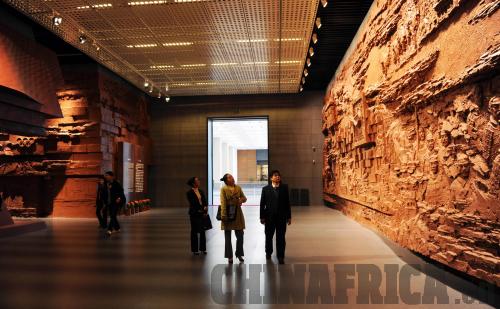|
 |
|
XINHUA |
After four years of renovation work and an expansion to its floor space, the National Museum of China (NMC) reopened on March 1 this year.
The museum, located on the east side of Tiananmen Square in Beijing, has nearly tripled in size from about 65,000 square meters to 191,900 square meters. It is now the largest museum in the world, said its official website.
New look
Besides expansion of size, the facilities of the new NMC have been greatly upgraded. The museum's interior is a combination of traditional and modern flavor. From west to east, there are three main halls inside the museum. The gate of the west hall has seven bronze gates engraved with decorative patterns of ancient bronze ware. The hall is an important entry and exit way, and from here visitors will enter an art gallery area along a 330-meter north-to-south axis and a 200-meter east-west corridor connecting all three halls.
The 2,000-square-meter central hall is used for opening ceremonies of important exhibits and events held at the museum. Four lounge halls are found on both sides of the hall.
The museum now has a total exhibition area of 65,000 square meters with 49 exhibition halls ranging in size from 800 square meters to 2,000 square meters. It also includes an Asia room, Africa room, Europe room and America room for exhibiting art and cultural relics of other countries.
The NMC's storeroom is over 30,000 square meters and can accommodate more than 1.2 million cultural relics. The temperature and the humidity there are controlled to protect the collections. Measures on lightning protection, anti-pollution, waterproofing, quakeproofing and fireproofing are state of the art.
The second floor of the new museum provides interactive experience for visitors of different ages and with different interests. Computer programs allow movies, opera, music, art, science and technology to be fully understood and appreciated by the public.
The new museum also has a theater with 800 seats, a 600-square-meter multimedia room and a conference hall with 300 seats. The multimedia room will allow visitors to get an up-close look at national treasures on display, said the Information Office of NMC.
One of the museum's more innovative features is its 20,000-square-meter rooftop green belt, the largest in Beijing. The green belt not only contributes to providing cleaner air to the city but also will help prolong the service life of the building material on the roof, an engineer of the NMC said.
Currently, the NMC houses as many as 1.06 million artifacts. Before the renovation work, there were 650,000 pieces in the museum's collection. In February 2010, the Ministry of Culture and the State Administration of Cultural Heritage transferred about 400,000 cultural relics to the NMC, said Lu Zhangshen, Curator of the NMC.
There are special exhibition halls for ancient arts, such as bronze art, figures of Buddha, porcelain, painting and calligraphy, furniture and coins, he said.
"The museum displays the history and civilization of the Chinese people, from the earliest trace of human existence through different dynasties right up to the present," said Dong Qi, Deputy Curator of the NMC.
Basic exhibitions in the museum will be free to the public, while some special exhibitions will charge a relatively small fee due to defray expenses.
"In consideration of security and the museum's atmosphere, we will charge a little to limit visitors. If we don't limit the volume of visitors, the museum will be too overcrowded and no one will be able to really enjoy the exhibits. Too many people will also make guarding the treasures more challenging," said Lu.
The museum restricts the number of visitors to a daily maximum of 8,000. Visitors can get their free tickets for the basic exhibitions at the north and west gates of the museum. It opens every morning at 9 a.m. and closes at 5 p.m. except Monday when the museum is closed.
|